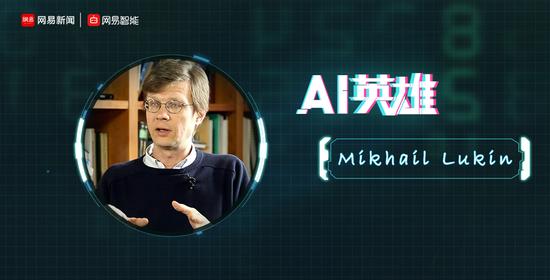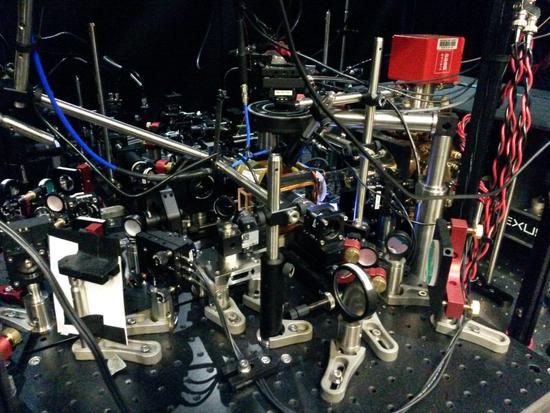
This article is produced by Netease Smart Studio (public number smartman163), this article is the AI ​​hero figure 59th.
From: Futurism
Compilation: NetEase See Compilation Robot
Review: Fu Zeng
Character point of view:
It may not take as long as 30 years for quantum computers to shift from scientific theories to popularization. This is an exciting field. We have entered a new era with great potential for scientific discovery. Soon we will begin to discover that quantum computers can play a wider role, including material science, chemistry, and physical systems. , artificial intelligence and machine learning, etc. - Mikhail Lukin
In the field of science and technology, we have been enthusiastic about the development of quantum computers for many years, but it has not yet entered our daily lives. Quantum systems can seamlessly encrypt data and help us understand and analyze the large amount of data that has been collected, and can even solve complex problems that even the most powerful supercomputer cannot solve, such as medical diagnosis and weather forecasting.
Immature quantum technology became closer to the proficiency we wanted in November of last year. At that time, Nature, one of the most famous scientific journals, published two articles, and the articles showed the latest research and development achievements of some of the most advanced quantum system technologies.
If you don't understand what a quantum computer is, what it does, or what it can do for you, you don't need to worry. Futurism News recently spoke with Mikhail Lukin, professor of physics at Harvard University, about the current state of quantum computing, including the possibility that we may use quantum technology on cell phones or desks someday, and What we need to do before this happens.
For clarity and conciseness, the content of this interview was revised in the later period:
Q: First of all, can you briefly introduce the working principle of quantum computing?
Mikhail Lukin: We started with the traditional methods of computer work. In a traditional computer, you use the form of some input to formulate any problem that you want to solve. Basically, it is a flow of data about an infinite number of combinations of 0s and 1s. When you want to do some calculations, you basically create some specific rules for the computer itself based on how the stream actually moves. The calculation process written in the normal machine has addition. Once it can do addition, it can do multiplication. Once multiplication can be done, basically the computer can process information omnipotently.
However, our microcosmic world has been formed for more than 100 years. Its basic principle is based on quantum mechanics. In quantum mechanics, there is often a corresponding system for management and application. For example, in two different states, your computer or your chair can be placed at the same time - this is the idea of ​​quantum superposition. In other words, your computer can be used at the same time in both Boston and New York. The concept of quantum superposition, even if it sounds weird, is recognized in the laws of quantum mechanics. If you consider a large area, such as the example I gave, this obviously sounds weird. But in the microscopic world, like single atoms, creating such a superposition is actually quite common. So scientists can demonstrate through these scientific experiments that an atom can be in two different states at the same time.
The idea of ​​quantum computers is basically to use these quantum mechanics rules to process information, so we can easily understand why it can be so powerful. In a traditional computer, you give me a corresponding amount of input information, I can put them on my computer, and let the computer give you output data. However, if our hardware uses quantum mechanics, then it is not just a matter of providing some input and answering answers sequentially. Using the state superposition principle, we can prepare a computer register to process many different types of input information.
This means that if I use this superposition and process it using quantum mechanics laws, then I can handle multiple inputs at once. This may be an exponential acceleration compared to traditional programs.
Q: What is the appearance of a quantum computer?
Mikhail Lukin: If you walk into a room with a quantum machine, you will see a vacuum chamber or duct, and a beam of laser light shining on it, and there is a very low density in the body The atom. We use lasers to slow the motion of atoms that are very close to zero in absolute energy, which is called laser cooling.
 Credit: Harvard University Lukin Laboratory
Credit: Harvard University Lukin Laboratory
Q: How do you program?
Mikhail Lukin: In order to make a quantum computer, we radiate 100 tightly focused laser beams into this vacuum chamber. Each of these laser beams serves as a diaphragm, and each beam can control one atom, but one may not hold it. When we have these atomic traps, we go through the atomic maps captured in these traps and find out which traps are full of atoms and which are empty. Then, we rearrange the traps that contain the single atom according to any pattern we want. This ideal arrangement in which individuals of a single atom are kept easy to control is essentially arbitrary.
Locating these atoms is a way of programming. In order to actually control quantum, we carefully push atoms from the lowest energy state into the higher energy state. We use a carefully selected laser beam to illuminate the transition of a specific atom, and their frequency needs to be kept under very strict control. In this excited energy state, atoms actually become very large, and because of this atomic size, atoms begin to interact with each other, or in other words: talk to each other. By selecting the states of our excited atoms and choosing their arrangement and location, we can program their interactions in a highly controlled manner.
Q: What is the most helpful application for quantum computers?
Mikhail Lukin: To be honest, we have no answer. It is generally believed that quantum computers do not necessarily help all computing tasks. But even the best traditional computers have a difficult time solving mathematical problems. Among these complex problems, problems such as complex optimizations are involved, and these problems include trying to satisfy some constraints on opposites.
Suppose you want to give a group of people a gift, and everyone has their own niche (Netease smart note: Niche, is a market segmented by the advantages of the company, this market is small, and not satisfactory Service, so for this gift, these different niches may be contradictory. So what happens is that if you solve this problem in the traditional way, you have to check every pair or group of people to ensure that at least their niche is satisfactory. The complexity of this problem grows very rapidly because the number of classic combinations you need to check is calculated on an exponential basis. Some people here believe that quantum computers have advantages over traditional computers for such problems.
Another very famous example is about solving the problem of factorization. If your number is small, say 15, it's obvious that its factors are 3 and 5, but as the numbers get bigger, this problem quickly becomes complicated. If you have a large number that is the product of two large numbers of factors, from a traditional perspective, there is no better way than looking for factors that change the numbers from 1, 2 and 3 in order. But it turns out that there is a quantum algorithm called the Shor algorithm that can find faster than the best-known classical algorithm. If you can do a method that has a much faster speed than using other methods, then we can say that this is a big gain.
Q: It sounds like your mission goal, and your mission is to help us advance and understand this technology, but application development related to quantum technology is secondary, because you think that when we have these tools, The application will naturally come to us. Am i right?
Mikhail Lukin: I will use an analogy to answer your question. When traditional computers were first developed, they were mostly used for scientific calculations and numerical experiments to understand the behavior of complex physical systems. Quantum machines are now at this stage of development. They have allowed us to study complex quantum physics phenomena. From this perspective, they are useful for scientific research, and scientists are now using them to help research.
In fact, one of the important points of our paper published in Nature magazine is that we have built large enough, complicated enough, and enough machines to help us conduct scientific experiments, even if it is the best tradition in the world. Computers, such as supercomputers, are also not likely to perform scientific experiments with quantum computers. In our work, we have used our machines for scientific discovery and have not made it before, in part because traditional computers are difficult to model these systems. In some ways, for example, for the purpose of scientific research, we think that quantum machines are more useful.
When traditional computers are under development, people have some ideas about which algorithms the computer should run. But in fact, when the first computer was built, people discovered more useful and effective algorithms when they started to use these computers, and they always did. In other words, it is when they discover that these computers can actually do better.
This is why I say we really don't know how big the potential of quantum computers is. The only way to find these tasks is to build large functional quantum machines to try these things. This is an important goal. I should say that we are now entering this stage. When we started experimenting with quantum algorithms on large machines, we were already very close to the goal.
Q: Please tell me something you mentioned in the article published in Nature magazine. What do you mean by "progress"? How close are we to finding algorithms that work on quantum computers?
Mikhail Lukin: Since you asked, first of all, let's talk about how a machine can meet the standards of a quantum machine. It should be able to operate along three different axes, one of which is scale - that is how many qubits can be accommodated (a "qubit", the "bit" in the unit "classical calculations" that forms the basis of the quantum computer), and The more, the better. The other axis is the degree of quantum, which determines the stability and consistency of the system. So the final way to quantify it is if you have a certain number of quantum and use this quantum calculation, then what is the probability that this calculation is error-free?
If you have a qubit, then you have a chance to make a small mistake. Once you have a lot, this probability rises exponentially. Therefore, the systems described in this paper and in the supplementary paper have sufficiently large qubits and are coherent enough that the entire series of calculations with a rather low error probability can be basically completed. In other words, in a limited number of attempts, we can get a result with almost no errors.
But this is not finished. We call the third axis how you can program with this machine. Basically, if you can interact each qubit with any other qubit in any way, then you can encode any quantum problem into this machine. This kind of machine is sometimes called a general-purpose quantum computer. The machines we have now are not completely generic (common), but we show very high programmability, so we can actually change the interconnections between them. These are the reasons why we are able to explore and discover these complex quantum phenomena.
Q: Is it possible that the size of a quantum computer can be reduced to the size of a cell phone, or can it be carried around to some extent?
Mikhail Lukin: Of course there is no problem. We have a variety of ways to package it so that it becomes a portable device that is as small as possible and may be smaller than a mobile phone, but it may also be as large as a desktop computer. However, the current technology can't do it yet.
Q: Do you think that, like traditional computers, quantum computers will shift from mere scientific discovery to popularization in the next 30 years or so?
Mikhail Lukin: I want to say that the answer is yes, but why does it take 30 years? Maybe faster.
Q: What will happen now and later? What kind of progress do we need?
Mikhail Lukin: I think we need computers that are big enough to really understand their use. We do not yet know what quantum computers can do, so we do not know their full potential. I think the next challenge is to do this.
The next stage will be to create machines that may be used for professional purposes to write related applications. People, including my team, are already developing some small quantum devices, such as medical diagnostic assistants. In these applications, quantum systems only measure tiny electric or magnetic fields, and using these data can make doctors diagnose more effectively. I think these things have arrived, and some of them have already been considered for commercial use.
Perhaps some general applications can be commercialized. In practice, quantum computers and traditional computers will probably work together. In fact, the most likely scenario is that most of the major work is done by traditional computers, but some of the most difficult problems can be solved by quantum computers.
There is also another area called quantum communication, which allows quantum states to be transmitted between stations and stations. If you use the quantum state to send information, you can build a completely secure communication line. And, through these so-called quantum networks, it is sometimes called Quantum Internet, and we should be able to remotely access quantum servers. In this way, I can certainly imagine the many possibilities that quantum computers can enter into everyday life, even if you can't put it in your pocket.
Q: How do you want more people to learn more about quantum computers?
Mikhail Lukin: Quantum computing and quantum technology have been proposed and studied for some time. We scientists all know that this is an exciting area because it is indeed a cutting-edge project that spans multiple subfields of scientific research. In the past five to ten years, most people think that the development of quantum science is very futuristic, because they think we need to create any useful quantum machine for a long time.
But this is not the case. I think we have entered a new era of enormous potential for scientific discovery. These discoveries may have wide applications in the field of material science and chemistry, and actually involve all parts of a complex physical system. But I also think that soon we will start to realize that quantum computers can play a wider role. From performance optimization to artificial intelligence and machine learning, I think these things are coming.
We do not know how quantum computers will do what I say, but I believe we will soon know. (Finish)
 ?
?
Click to view the "AI Heroes" topic, the past content step by step!
Note: "AI Heroes" is an exclusive interview with Netease Smart Studios. It tells a story about artificial intelligence every week, and gives insight into technology trends, capturing industry opportunities, and paying attention to people's value. Please indicate the source, please leave!
Zhejiang Synmot Electrical Technology Co., Ltd , https://www.synmot-electrical.com